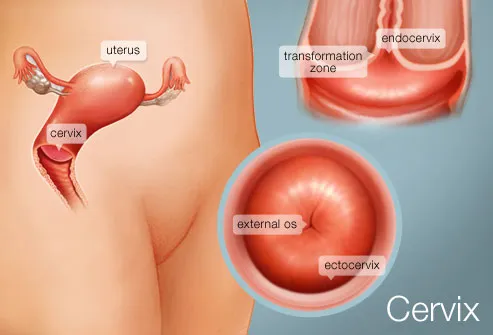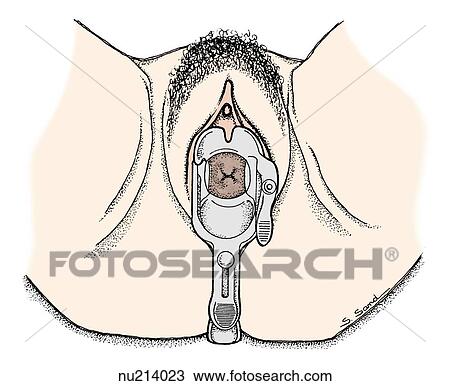
THE CERVIX is a cylinder-shaped neck of tissue that connects the vagina and uterus. The cervix is made of cartilage covered by smooth, moist tissue, and is about 1 inch across. There are two main portions of the cervix:
- The part of the cervix that can be seen from inside the vagina during a gynecologic examination is known as the ectocervix. An opening in the center of the ectocervix, known as the external os, opens to allow passage between the uterus and vagina.
- The endocervix, or endocervical canal, is a tunnel through the cervix, from the external os into the uterus.
The overlapping border between the endocervix and ectocervix is called the transformation zone.
The cervix produces cervical mucus that changes in consistency during the menstrual cycle to prevent or promote pregnancy.
During childbirth, the cervix dilates widely to allow the baby to pass through. During menstruation, the cervix opens a small amount to permit passage of menstrual flow.
CERVICAL EROSION is the inflammation of cervical cells which causes vaginal discharge, bleeding during sexual intercourse and in between periods.
Cervical erosion is one of the reasons women seek gynecological advice, of which some are admitted and more are treated as outpatients. Cervical erosion is a very common finding on routine gynecological examination of a woman during her childbearing years.
Erosion is defined as wearing away of tissue. The cervix is lined by two types of cells- outer part by flat squamous cells and the inner part by glandular cells that secrete mucus (columnar). Thus the term cervical erosion is something of a misnomer as the squamous lining of the cervix is not lost but replaced by the columnar epithelium of the inner cervix (endocervix). Therefore the term ectropion is now more prevalent.
As the time elapses, squamous metaplasia may occur in this columnar epithelium.

NORMAL LOOKING CERVIX ON SPECULUM EXAM


CERVICAL EROSION SEEN ON SPECULUM EXAM
HOW SPECULUM EXAM IS DONE ON ROUTINE GYNECOLOGICAL CHECKUP

A SPECULUM

DISPOSABLE TYPE OF SPECULUM



CAUSES
Though cervical erosion is a common finding during fertile years, its significance is variable. Causes of erosion can be
trauma,
chemicals,
infections
or carcinoma.
Trauma of multiple childbirths, tampon use or an intrauterine contraceptive device especially if used for a long period can cause erosion.
Cervical erosion is commonly related to the effect of hormones and is seen in young women taking oral contraceptive pills.
Acute and chronic infections are common causes of erosion. The duration of infection is more important than the type.
The most serious concern with cervical erosion is its likely predisposition to cause cervical cancer. Cervical erosions are more common in women of lower socioeconomic groups, women with poor general hygiene, with early marriage and multiple pregnancies. These are also the risk groups for cervical dysplasia which are precancerous lesions.
SIGNS AND SYMPTOMS
Cervical erosion is mostly an incidental finding on routine gynecological examination in women. Commonly it is present in asymptomatic females. The common symptoms associated with cervical erosion are – vaginal discharge or leucorrhoea, pain, difficulty in passing urine, post coital bleeding.
The frequency of infection is more as the changes in the epithelium due to cervical erosion creates a favorable milieu for organisms to grow. On gynecological examinations cervix appears red and granular. Pap smear is usually normal, but may show signs of infection or some abnormal cells. Therefore Pap smear usually helps to decide if treatment is needed or not. Cone biopsy is done if indicated.

TREATMENT
Mostly cervical erosion is present in women who do not have any symptoms and thus no specific treatment is advised.
Usually a spontaneous regression takes place after the squamous metaplasia, but treatment can speed up this process. It is only if the patient with cervical erosion presents with a specific complaint e.g. excessive vaginal discharge or post coital bleeding then treatment is advised for the underlying cause like infection.
Treatments usually advised are cryocauterization, electrocoagulation, and cautery with laser or drug treatment.
Cervical erosion with dysplastic changes on Pap smear should be investigated for precancerous changes and be regularly followed up as these may lead to cervical malignancies. It is recommended that cervical erosions in women of non-childbearing age should be investigated and treated as these could be suspicious.
If you a woman of childbearing age you should go for regular gynecological checkup. It could save you from a lot of future gynecological problems!
SOURCE: mdhil.com
webmd.com
google.com
fotosearch.com
No comments :
Post a Comment